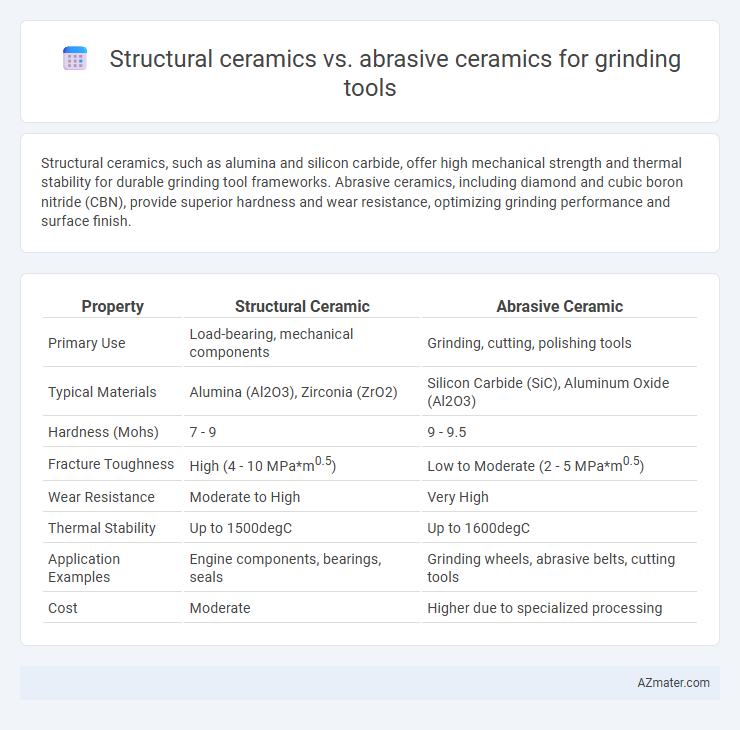Structural ceramics, such as alumina and silicon carbide, offer high mechanical strength and thermal stability for durable grinding tool frameworks. Abrasive ceramics, including diamond and cubic boron nitride (CBN), provide superior hardness and wear resistance, optimizing grinding performance and surface finish.
Table of Comparison
| Property | Structural Ceramic | Abrasive Ceramic |
|---|---|---|
| Primary Use | Load-bearing, mechanical components | Grinding, cutting, polishing tools |
| Typical Materials | Alumina (Al2O3), Zirconia (ZrO2) | Silicon Carbide (SiC), Aluminum Oxide (Al2O3) |
| Hardness (Mohs) | 7 - 9 | 9 - 9.5 |
| Fracture Toughness | High (4 - 10 MPa*m0.5) | Low to Moderate (2 - 5 MPa*m0.5) |
| Wear Resistance | Moderate to High | Very High |
| Thermal Stability | Up to 1500degC | Up to 1600degC |
| Application Examples | Engine components, bearings, seals | Grinding wheels, abrasive belts, cutting tools |
| Cost | Moderate | Higher due to specialized processing |
Introduction to Structural and Abrasive Ceramics
Structural ceramics possess high strength, toughness, and thermal stability, making them ideal for load-bearing components in grinding tools. Abrasive ceramics, characterized by exceptional hardness and wear resistance, are specifically engineered to grind, cut, and finish materials efficiently. Understanding the distinct material properties of structural and abrasive ceramics is essential for optimizing grinding tool performance and durability.
Composition and Material Properties
Structural ceramics for grinding tools are typically composed of alumina (Al2O3), silicon carbide (SiC), or zirconia (ZrO2), offering high hardness, excellent fracture toughness, and thermal stability. Abrasive ceramics mainly consist of fused aluminum oxide or silicon carbide particles bonded by vitrified or resin bonds, designed to provide superior cutting ability and wear resistance. The key material properties distinguishing them include higher fracture toughness and mechanical strength in structural ceramics versus enhanced abrasiveness and surface finish quality in abrasive ceramics.
Manufacturing Processes
Structural ceramics for grinding tools are typically manufactured using powder compaction methods followed by high-temperature sintering to achieve dense, strong microstructures essential for mechanical stability. Abrasive ceramics undergo additional processes such as doping with hard particles like silicon carbide or aluminum oxide and precision machining to enhance hardness and wear resistance critical for effective grinding performance. Both types rely on controlled grain growth and porosity management during manufacturing to optimize their functional properties in grinding applications.
Mechanical Strength Comparison
Structural ceramics exhibit higher mechanical strength and fracture toughness compared to abrasive ceramics, making them suitable for load-bearing grinding tool components. Abrasive ceramics prioritize hardness and wear resistance, often sacrificing mechanical strength, resulting in increased brittleness under stress. The choice between structural and abrasive ceramics impacts grinding tool durability, with structural ceramics offering enhanced resistance to mechanical failure during high-stress operations.
Abrasion Resistance and Wear Performance
Abrasive ceramics in grinding tools typically exhibit superior abrasion resistance and wear performance compared to structural ceramics due to their high hardness and toughness, which enables efficient material removal and prolonged tool life. Structural ceramics prioritize mechanical strength and thermal stability, resulting in moderate wear resistance but increased resistance to mechanical shock. The optimized microstructure and hardness of abrasive ceramics make them ideal for high-precision grinding applications demanding consistent surface finish and minimal tool degradation.
Applications in Grinding Tools
Structural ceramics in grinding tools provide exceptional wear resistance and mechanical strength, making them ideal for precision grinding of hard metals and complex geometries. Abrasive ceramics, composed of super-hard materials like silicon carbide or aluminum oxide, excel in high-speed grinding and material removal applications for tough alloys and composites. Both types enhance tool life and surface finish quality, with structural ceramics favored for durability and abrasive ceramics prioritized for aggressive cutting efficiency.
Cost and Availability
Structural ceramics, such as alumina and zirconia, generally offer lower cost and higher availability compared to abrasive ceramics like silicon carbide and cubic boron nitride, which are more expensive due to their specialized manufacturing processes. The broader industrial use and mass production of structural ceramics contribute to their affordable pricing and easy accessibility for grinding tools. Abrasive ceramics, however, deliver superior cutting performance but with limited availability, impacting overall tool cost and procurement timelines.
Lifespan and Maintenance
Structural ceramics used in grinding tools provide superior lifespan due to their high hardness and fracture toughness, enabling extended service under heavy mechanical stress. Abrasive ceramics, designed for cutting and material removal, typically wear faster but require less frequent maintenance because they maintain sharp edges longer and generate less heat during operation. Optimizing tool choice between structural and abrasive ceramics depends on balancing durability against maintenance intervals to maximize productivity and reduce downtime.
Environmental Impact
Structural ceramics used in grinding tools typically exhibit higher durability and longer service life, reducing waste and the frequency of replacements, which lowers overall environmental impact. Abrasive ceramics, while effective in material removal, often wear out faster, generating more particulate waste and increasing resource consumption for manufacturing. Optimizing the choice between structural and abrasive ceramics directly influences energy efficiency and the sustainability of grinding operations.
Choosing the Right Ceramic for Grinding Tools
Selecting the right ceramic for grinding tools depends on the specific application requirements; structural ceramics like alumina and zirconia offer high strength and toughness, ideal for precision grinding and heavy-duty tasks. Abrasive ceramics, composed of materials such as silicon carbide and cubic boron nitride, provide superior hardness and wear resistance, making them suitable for grinding hard metals and abrasive materials. Understanding the balance between toughness, hardness, and thermal stability ensures optimal performance and tool longevity in various grinding operations.

Infographic: Structural ceramic vs Abrasive ceramic for Grinding tool
 azmater.com
azmater.com